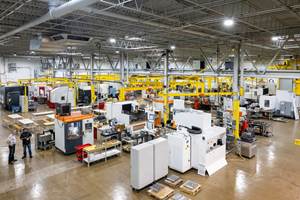Working on the Workforce
Editorial Advisory Board (EAB) Insight from Mike Zacharias.
Share
Read Next
As president of Extreme Tool and Engineering, I have the opportunity to travel the world and experience firsthand the operations of customers and competitors. Almost universally, the No. 1 pain point discussed is hiring good people and finding enough qualified workers.
Extreme has committed to meeting this challenge head-on by turning it into a competitive advantage. We do this by breaking down workforce development into four main components and working on each one: 1) education, 2) recruitment, 3) training and 4) retention.
Following is an explanation of each core component with perspective on what each one means in today’s world.
1. Education. In order to find the best candidates for employment, you need to educate people on the types of opportunities available at your facility. Students, teachers, advisors, parents and prospective employees all need to be informed about the type of people you need, the kind of facilities you operate and the advancement opportunities you offer.
Do not assume the general population understands what you do and how you do it. Take time to engage civic organizations, trade associations and local educational entities to actually demonstrate what you do and who you are. Offer tours and open houses. Provide opportunities to show off your plant any time you can.
Equally important is building the case for why people should work for you. Build such a case with data that accurately illustrates why your company is the best option among other career choices, as well as among your competition.
2. Recruitment. Finding good people is never easy. Build relationships and a network that help keep your talent pipeline full. More importantly, understand and know that no one can or will sell the opportunities within your company any better than the employees who already work for you.
Provide incentives for employees to recommend a friend when an opening exists. How many people would recommend someone to work alongside them who couldn’t pull his own weight? Most importantly, become an employer of choice in your area. If you provide the best jobs in town and people seek out your company for employment, then you’ve already solved part of the workforce challenge.
3. Training. If you haven’t already, it’s time to get more serious about employee training and development. In the past, everyone assumed people would “learn it” and “get it” by “being around it,” but now employing a full-time director of training and continuous improvement can be a successful strategy. The primary responsibility of this role is to ensure that a formal plan is in place for employees to realize their potential. This person will have time to do this because it is his or her job, not something he or she does when there is nothing else to do.
4. Retention. No one wants to train and develop people only to lose them to the competition, therefore it is critical to create a culture within your organization that drives people to want to work for you for an extended period of time.
For example, we rebranded the company recently and established core values for the organization during that process. Although initially viewed as a simple marketing and sales opportunity, it became apparent how important it is to sell who we are not only to our customers, but more importantly, to our existing and prospective employees. Life changes and businesses develop, but one thing that has never changed is the need for good people. Ask yourself, “What am I doing to make sure I have the best employees in the world?”
Related Content
Tackling a Mold Designer Shortage
Survey findings reveal a shortage of skilled mold designers and engineers in the moldmaking community, calling for intervention through educational programs and exploration of training alternatives while seeking input from those who have addressed the issue successfully.
Read MoreHow to Improve Your Current Efficiency Rate
An alternative approach to taking on more EDM-intensive work when technology and personnel investment is not an option.
Read MoreCross Training, In-House Capabilities and Collaborative Design Move Helm Tool Forward
Cross-training, bringing it all in-house, molding and collaborative design are essential to Helm Tool's success.
Read MoreMMT Chats: The Science of Moldmaking, Part 2
In Part 2 of this two-part MMT Chat, Christina and Don continue their conversation by exploring lean manufacturing and tips on how to attract, train and retain the future workforce.
Read MoreRead Next
How to Use Strategic Planning Tools, Data to Manage the Human Side of Business
Q&A with Marion Wells, MMT EAB member and founder of Human Asset Management.
Read MoreAre You a Moldmaker Considering 3D Printing? Consider the 3D Printing Workshop at NPE2024
Presentations will cover 3D printing for mold tooling, material innovation, product development, bridge production and full-scale, high-volume additive manufacturing.
Read MoreHow to Use Continuing Education to Remain Competitive in Moldmaking
Continued training helps moldmakers make tooling decisions and properly use the latest cutting tool to efficiently machine high-quality molds.
Read More

























